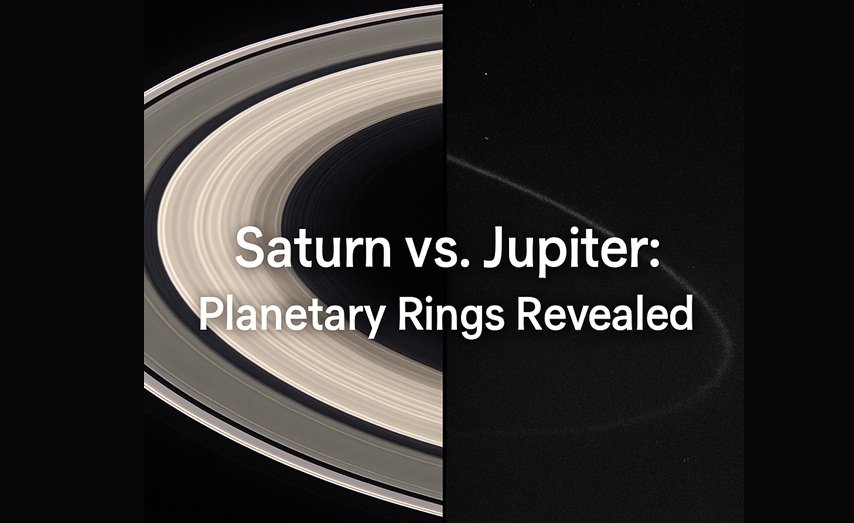
Introduction
When you think of planets with spectacular rings, Saturn probably comes to mind first — and for good reason! Saturn’s rings are iconic, easily visible even through small telescopes, and have fascinated humans for centuries.
But what about Jupiter?
Does Jupiter also have rings?
Surprisingly, yes — it does!
Although much fainter and harder to see, Jupiter also has its own ring system.
In this detailed article, we’ll explore:
- Which planets have rings
- Differences between Saturn’s and Jupiter’s rings
- Why Saturn’s rings are so famous
- How the rings were discovered
Saturn: The King of Rings
Saturn’s Ring System
- Appearance: Bright, wide, and extensive.
- Visibility: Easily seen from Earth with small telescopes or even binoculars.
- Structure: Made up of seven main rings divided into thousands of smaller ringlets.
- Composition:
- Mostly water ice mixed with dust and rocky debris.
- Ice particles range from microscopic grains to chunks as large as mountains.
- Size:
- The rings span up to 280,000 km (175,000 miles) from the planet but are only about 10 meters (30 feet) thick.
Saturn’s rings are so prominent because of their brightness (high albedo due to ice) and enormous spread relative to the planet.
How Were Saturn’s Rings Discovered?
- Galileo Galilei first observed them in 1610 through an early telescope.
- Initially, he thought Saturn had “ears” or “handles.”
- It wasn’t until Christiaan Huygens in 1655 that the true nature of the rings was correctly proposed.
Jupiter: The Hidden Rings
Does Jupiter Have Rings?
- Yes, Jupiter does have rings — but they are extremely faint.
- Discovery:
- First detected in 1979 by the Voyager 1 spacecraft.
- Later confirmed and studied by missions like Galileo and New Horizons.
Structure of Jupiter’s Rings
- Jupiter’s ring system is composed of three main parts:
- Halo Ring: A thick, inner torus of particles.
- Main Ring: A thin and relatively bright ring.
- Gossamer Rings: Two wide, faint outer rings named after the moons Amalthea and Thebe.
Composition
- Made mostly of tiny dust particles rather than ice.
- Dust is thought to come from meteoroid impacts on Jupiter’s small inner moons.
- Because the dust is dark and small, Jupiter’s rings are not easily visible — even with Earth-based telescopes.
Saturn vs. Jupiter: Ring Comparison
| Feature | Saturn | Jupiter |
|---|---|---|
| Visibility | Very bright, easy to see | Extremely faint, hard to detect |
| Composition | Water ice and dust | Dust particles |
| Thickness | About 10 meters | Very thin |
| Discovery | 1610 (Galileo, with early telescope) | 1979 (Voyager 1 spacecraft) |
| Structure | Complex, many distinct rings | Few, simple, faint rings |
Why Are Saturn’s Rings More Famous?
- Reflectivity: Ice reflects sunlight better than dust.
- Size and Scale: Saturn’s rings are huge and dramatically spread out.
- Brightness: Easily visible even with basic amateur telescopes.
- History: Observed centuries earlier than other planetary rings.
Thus, in the public imagination, rings = Saturn, even though other gas giants also have them.
Other Planets With Rings
Besides Saturn and Jupiter, two other giant planets also have ring systems:
- Uranus:
- Has 13 faint rings.
- Dark and narrow.
- Discovered in 1977.
- Neptune:
- Has five main rings.
- Very faint and dusty.
- Discovered in 1984 from Earth-based observations.
Conclusion
Saturn is rightly celebrated as the planet with the most spectacular and visible rings, but Jupiter does have its own, much fainter ring system.
In fact, all four gas giants — Jupiter, Saturn, Uranus, and Neptune — have rings!
What makes Saturn unique is the sheer brightness, size, and beauty of its icy rings, a natural wonder visible from millions of kilometers away.
Next time you gaze at Jupiter, remember: hidden in the planet’s glow are delicate rings made of cosmic dust — silent, faint, but very real.
Explore Quizzes:
- What’s Five Times Hotter Than the Sun That Can Be Found on Earth?
- Are Mushrooms Plants or Animals?
- What is the Original Purpose of Bubble Wrap?
- Does It Snow in South India? A Look at Lambasingi
- Who was the first player to take a wicket on 0th ball in men’s international cricket
- Why Was Air Conditioning Invented?
- What is the southernmost point of India?
- Why Was Rumali Roti Created? History, Origin & Culinary Significance







